
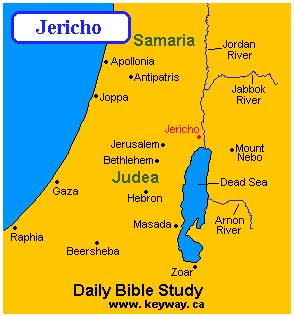


Jericho is a city located near the Jordan River in the West Bank of the Palestinian territories. It is the capital of the Jericho Governorate and has a population of more than 20,000. Situated well below sea level on an east-west route 16 kilometres (10 mi) north of the Dead Sea, Jericho is the lowest permanently inhabited site on earth. It is also believed to be one of the oldest continuously inhabited cities in the world.
Demographics have varied widely depending on the dominant ethnic group and rule in the region over the past three thousand years. In a 1945 land and population survey by Sami Hadawi, 3,010 inhabitants is the figure given for Jericho, of which 94% (2840) were Arab and 6% (170) were Jews.
In the first census carried out by the Palestinian Central Bureau of Statistics (PCBS), in 1997, Jericho's population was 14,674. Palestinian refugees constituted a significant 43.6% of the residents or 6,393 people. The gender make-up of the city was 51% male and 49% female. Jericho has a young population, with nearly half (49.2%) of the inhabitants being under the age of 20. People between the ages of 20 and 44 made up 36.2% of the population, 10.7% between the ages of 45 and 64, and 3.6% were over the age of 64.
Based on PCBS projections, Jericho presently has an Arab Palestinian population of over 20,000. The current mayor is Hassan Saleh, a former lawyer.
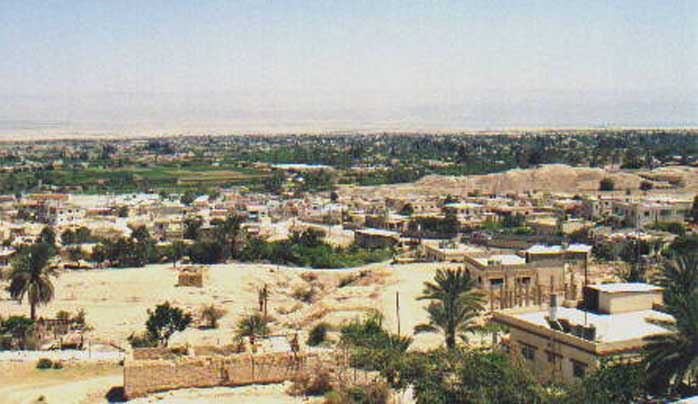
Described in the Old Testament as the "City of Palm Trees", copious springs in and around Jericho have made it an attractive site for human habitation for thousands of years. It is known in Judeo-Christian tradition as the place of the Israelites' return from bondage in Egypt, led by Joshua, the successor to Moses. Archaeologists have unearthed the remains of more than 20 successive settlements in Jericho, the first of which dates back 11,000 years (9000 BCE), almost to the very beginning of the Holocene epoch of the Earth's history.
The origin of the name, "Jericho" is Semitic. The common people pronounce it "Riha". To the Cananaites it meant "the moon". The word is derived from the verb "yerihu", and "Yarah". Al-Yarah in the language of southern Arabia means "a month" and "moon". In Hebrew "yarihu" is the most ancient known city in the Jewish Bible. "Riha" in Syriac means "scent and odor."
The Arabs knew the city of Jericho referred to in the Bible by the name "Raiha" and "Ariha".Yaqut, the writer of "Mu'jam al-Buldan," mentions that it is the city of Al-Jabbarin (the Mighty) in the Ghaur, and that it was called Ariha Ibn Malik Ibn Arfakhshad Ibn Sam Ibn Noah, may peace be upon him.
The city of Jericho was called "Wadi As-Saisaban, Valley of Sesban". It was given this name because of the abundance of a certain plant that grows there. It densely entwines round its groves like a fence, and is still found there.
It was also called, " Tall As-Sultan " ( the Hill of the Sultan ) or " Ain Alisha' " ( The Spring of Alisha' ), as ancient Jericho was merely a small artificial hill called " Tall as-Sultan ", which is the precursor ( origin ) of the first city. It was also called " Madinat an-Nakhil " (The City of Palms) because palm trees grow in its soil and are abundantly found in it. It was also called " Ruwaiha " ( the diminution of Raiha' ) which is eight miles away to the south east of present Jericho. Rousseau has defined Ariha and Riha as each one is applicable, to the city and region together.
Jericho is one of the most ancient human habitations. The most ancient human remains were found in it, some of which go back to 5000 years B.C. Others believe that these remains go back to 7000 years B.C. The most recent opinion on this subject is that they date back to 8000 years B.C.
The site of ancient Jericho is half a kilometre away from modern Jericho at a depth of 820 feet ( 250 metres) below sea level. It lies at latitude 31 52 degrees north and longitude 35 39 degrees east.
The evidence indicating that it is one of the most ancient cities in the world is borne up by a series of excavations made at " Tall as-Sultan ", which is oval in shape, formed by the successive accumulation of ruins with the passing of time. Excavations have been continuing successively since the middle of the nineteenth century up till now.
The German-Austrian Mission in which the two archeologists E. Sellin and C. Watzinger worked, was the first one to be interested in uncovering the antiguities of Jericho, and that was in 1911. They were succeeded by the English, who conducted excavations at Tall as-Sultan under the supervision of first J. Garstang ( 1930-1936 ) and completed by Miss K. Kenyon ( 1952-1961 ). She published a resume of her work in two huge volumes ( 1960-1965 ). She is considered to be the greatest authority on this subject. She is the one to have estimated the age of the city to be 8000 years B.C. Its habitation certainly started about that time which undoubtedly makes it the most ancient known city in the world.
That is why it is probable that the most ancient civilization in the world did not appear in the Nile Valley or the Tigris and Euphrates Valley, but in the Jordan Valley. Dr. Kenyon gave the name of " Ariha al-Ula " ( The first Jericho ) to the first construction of the city which was sacked and destroyed as a result of invasions, earthquakes and fire time and again. Every time it was destroyed it rose once again on the ruins of the past Jericho. Kenyon and the archeologists who preceded her were able to distinguish between the successive periods Jericho passed through.
By about 7000 B.C. Jericho had developed into a large settlement which may have contained as many as two thousand individuals, and was defended by a substantial wall. The dead were often buried beneath the floors of houses. In some instances the bodies were complete, but in others the skull was removed and treated separately, with the facial features reconstructed in plaster.
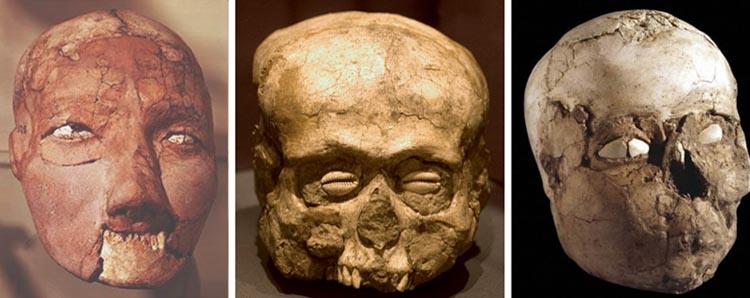
1. The pre-Stone Age or the first Neolithic Age in Jericho 6800 B.C.
Excavations have revealed that the ancient city was inhabited during four successive intervals during this age. The first was the first Neolithic Time. In this it was inhabited by a folk called " An-Natifiyyun ", who depended for their food on collecting wild seeds. It is probable that they did not plant seeds in reality, but owned scythes with flint edges, straight bone handles to harvest wild seeds, and stone mortars with handles for grinding them. Some of these groups lived in caves, while other groups occupied primitive villages excelling in the art of architecture. So they started to build round huts from sun-dried bricks flat at the bottom curving at the higher edge. They used to bury their dead with their personal jewelry in graves hewn out of rock.
These folks dug out canals using the waters of " Ain as-Sultan to irrigate their lands. They constructed huge walls two metres wide round their villages. They erected in them a circular huge tower, nine metres ( thirty feet ) in diametre, and ten metres high. In its midst there are stairs leading from the bottom of the town to its top. They were exposed to the attacks of groups from outside. These folks practised agriculture, the domestication of animals, and weaving the making chains and mats, as well as animal hunting. They used spears and flint-capped arrows. They also used hatchets to cut tree branches. These groups had started to expand from their settlements in search of new homes outside their boundaries.
2. The pre-Clay Age or the Second Neolithic Age in Jericho, 5500 B.C.
The building of houses in this interval showed a great progress. Their rooms were about 6.5 metres by 5 metres or 3 by 7 metres. They were usually of a rectangular shape built in an open yard, seven metres long and seven metres wide and used for cooking. The thickness of their wall was half a metre. They used stones to build the foundation, and the rest of the building was built of sun-dried bricks. Its shape was similar to the iron used for cauterising animals. So the brick was rectangular in shape with sharpened edges. The floor formed was of a mud layer topped by a layer of lime, followed by soft lime dyed red or light blue. Then it was polished to acquire a new lustre.
Its houses were of one or two stories. The ceiling was built of reeds and mud. Their flint intensils were sharp-edged. Small statues were made of unbaked mud. In the past these statues possessed a religious significance. Female statues might indicate the fertility goddess. It seems that these folks practiced the worship of ancestors as nine skulls were found whose facial features were painted with lime with two mother-of-pearl eyes placed on their faces.
3. The Late Neolithic Age in Jericho : between 5000-4000 B.C.
This Age preceded by many centuries the discovery of pottery. The people who lived in this period were raiders coming from outside. They settled at Tall, and might have been nomadic Bedouins. Their looms have been found but their homes have disappeared. Jasper beads and pierced mother-of-pearl were found to be possessed by them. They buried their dead collectively in special vaults inside the city. They kept skulls in particular in the mausoleum of prominent men of their age. The lifespan of many of them is estimated, in the light of their remains to be 35 years. Few of them reached the age of 50. This Age is divided into two periods:
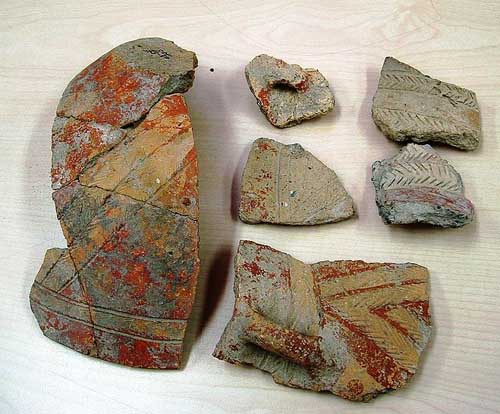
People in this age lived in pits. They worked in agriculture and in domesticating animals. They introduced the manufacture of pottery to their homes, but it was a primitive and rough one painted in red in geometrical figures.
People in this age were a great deal more advanced than their predecessors, as they lived in huts built of clay and manufactured earthenware in inclined lines.
By about 4,000 B.C, there existed small settlements of farming people who built mud-brick houses and some underground dwellings. In the Early Bronze Age, the inhabitants of Canaan, built the first walled towns. These towns were small with walls of rough stones or unbaked mud brick.
The town were surrounded by peasant farmers growing a range of local horticultural products, along with commercial growing of olives, grapes for wine, and pistachios, surrounded by extensive grain cropping, predominantly wheat and barley. Harvest in early summer was a season when transhumance nomadism was practiced - shepherds staying with their flocks during the wet season and returning to graze them on the harvested stubble, closer to water supplies in the summer.
As time progressed, the fortifications in these early towns grew more complex. By the end of the Early Bronze Age, some towns were surrounded by double and triple walls, for defense. Families lived within these city walls, in houses clustered around courtyards. The existence of these heavily fortified city walls, is evidence that this was not a peaceful period. Evidence seems to indicate that they buried their dead in stone dolmens.
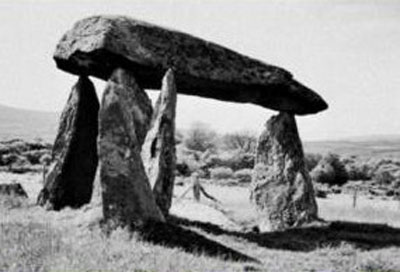
The date of man's habitation therevcan be traced back to about 3200 B.C. The best illustration of this can be found in tombs. The main cemeteries of old Jericho are found on the site on which the 'Aqapat Jabr refugee camp stands from the northern part. Some graves were dug up in the streets and courtyards of the camp. The most interesting of these graves is one which goes back to that age, as it was found as a result of an examination by carbon number 14, that its history goes back to c. 3260 BC. That grave contained 113 skulls arranged round the tomb's chamber. The center of the chamber contained a heap of burnt bones.
Some of the skulls carried the traces of scorching a heap of burnt bones. Some of the skulls carried the traces of scorching but were not deliberately burnt. This indicates the existence of certain strange customs in connection with burial rites. we also conclude that the bodies of the dead were first placed in the open until the flesh was decomposed and separated from the bones.
The collecting of these numerous bone skeletons followed, with the skulls being symmetrically arranged in a row round the tomb's chamber with their faces directed towards the inside. The bones were heaped in the middle with the necessary inflammable material. Then it was set on fire.
When the heap cooled down after burning, the funeral offerings made mostly of earthenware, were placed in the grave, while the burnt bones were covered by a layer of stone chips. In reality, the other archeological discoveries in Palestine and Trans-Jordan did not produce any evidence corroborating the existence on these customs, though the custom of exposing bodies in the open, until the flesh disintegrated was not a custom remote from what was familiar.
We have nothing about those people except that they were the pioneers of the following age, that is the First Bronze Age, which was the most prosperous one in Jordan and Palestine. We see the features of the First Bronze Age, which extends from 2900 B.C, evidently clear in Jericho especially with regard to defensive fortifications in the town. These fortifications were, no doubt, supremely important.
The defensive walls were repaired and rebuilt sixteen times during the First Bronze Age which lasted 600 years. It is often difficult to indicate the various periods when the renewal of the building of the walls was made, as they used to fall down as a result of earthquakes, or because of infiltration of water into their foundations, and the people were prompt to repair them.
Some destruction befell the walls as a result of enemy attacks. In any case there appear on these walls during that period the traces of destruction and ruin, but traces of repairs and renewed building are also apparent on then. This goes to show that the inhabitants of the town lived a life devoid of security and stability.
Nevertheless, the general picture shows a continuous improvement in the fields of civilization and construction as people started to use copper in large quantities in order to manufacture weapons and tools. Pottery utensils show an abundance of trade exchange with all neighboring valleys.
This period revealed a great progress in civilization, as it was accompanied by the appearance of new towns in numerous sites that had been hitherto uninhabited. But this civilization, along with other civilizations preceding it, crumbled and came to an end at the hands of Bedouin raiders. It seems that the people at the end of First Bronze Age started to enjoy a greater stability and tranquility leading to the neglect of these defensive fortifications.
But then came a time in which they woke up from their heedlessness because the latest wall, dating back to that period reveals quick poorly contructed repairs on the remains of a wall previously constructed. The foundation stones appear as if they had been hurriedly dropped and with no organization. Then the wall started to be built of baked brick moulds over the stones. Baked brick moulds used in other walls appear on this wall. But calamity overtook those folks before they completed the construction of that wall which was itself destroyed by fire, and the town fell into the hands of raiding Bedouin tribes.
After this date new inhabitants settled in Jericho. They resided first on the top of the Hill. They built for themselves some ramshackle homes. The spread of these homes stretched on the Hill slopes, as there was no defensive wall in that interval.
There is an edifice on the western side which may have been originally a temple, as what resembles an altar was discovered together with the remains of a small animal under its foundations. This period is known as marking the beginning of the Middle Bronze Age.
In reality the tombs of those people attracted most attention, contrary to the collective cemeteries where the dead used to be buried in previous ages. They buried one dead person in every grave only placing with him some chattels and jewelery.
Graves stretching 248 metres from the original three hundred and sixty metres were discovered at Tall A-Sultan. Some of these graves were very wide with the pit's width being three metres and its depth five metres. The dimensions of the mausoleum chamber were 360, 330 and a height of 260 cms, which necessitated digging out 150 tons of rocks, and all this was for the sake of burying one person.
We can see that bodies were exposed until the bones were stripped off before they were buried, as the folks who came before them did. The objects placed inside the grave varied in accordance with the models of graves. In some of them there was nothing save a dagger, in others pins and beads ( presumably these belonged to women ).
In some others some pottery utensils only were found, while in other tombs a number of jars, a dagger or a spear head. Nevertheless all these had one thing common namely the existence of a small niche hewn out of the wall of the mausoleum chamber. It contained a four-headed lamp, the type which was prevalent in that period. It appears that on the smooth surface of a rock of the corners of a grave that someone had drawn some small pictures in the form of a goat or an ibex or a tree, in addition to two men armed with spears and shields.
This is, as we know, the only known illustration from these people. Then earthenware utensils are not distinguished for accuracy and mastery, having no adornment except for some circular lines which are colorless, and no paint of any sort, a proof that they were only made then for utilitarian use without any interest to decorate them.
It is probable that these new inhabitants were no other than the Amorites who occupied most of the Middle Eastern countries, including Iraq and Egypt, during the period between 2300-1900 B.C. But they themselves were the victims of a greater invasion by the Hyksos.
Jericho was one of the strong-holds of the Hyksos or Shepherd Kings 1750-1580 B.C. as the Bible calls them. It is believed that they brought horses with them, and perhaps the chariot, to Palestine and Egypt.
Their houses were well built and covered the whole top of the Hill. Before their arrival the town was surrounded by a strong baked bricks, wall. They introduced a brand new system of defensive fortifications, not to Jericho alone, but also to all parts of Palestine. This new defensive system consisted of a steep earth slope topped by a wall made of moulded baked bricks.
The tombs of this period are generally characterized by being the tombs of ancient people reused. One can see the grave chamber covered by a big stone, and the opening filled with earth. It seems that the reason for the preservation of things in good condition is accounted for by the infiltration of gases from cracks in the rock. They were accumulated in the chamber eradicating moth and disintegration germs.
Wooden tables, baskets, seats, stuffing and artificial hairs, and even pieces of votive offerings' flesh were found, all remaining in a good condition. All tombs were in the shape of collective mausoleums. They used to accumulate the bone skeletons and first offerings in the corners to leave room for the new dead. In the Palestine Archeological Museum in Jerusalem there is one of these tombs, constructed in accordance with the condition in which it was in the ancient times. Jericho was the third city in importance as its geographical situation had the advantage of controlling the direct route with the lands rich in cereals in TransJordan.
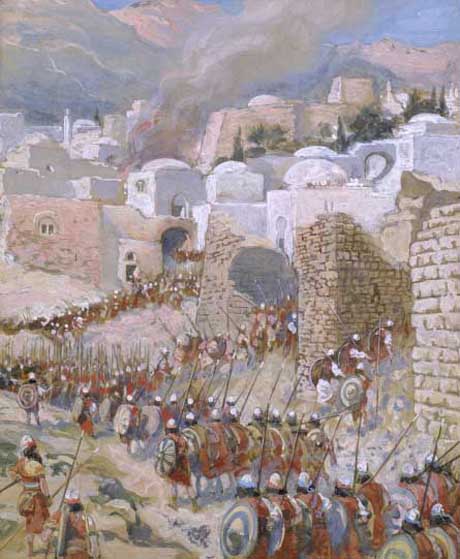
Jericho was a very important city in 1400 BC. Houses were built near the site of Al-'Ain where a fortress gate stood. The area of the city was six acres in their time, and its walls reached a height of twenty one feet.
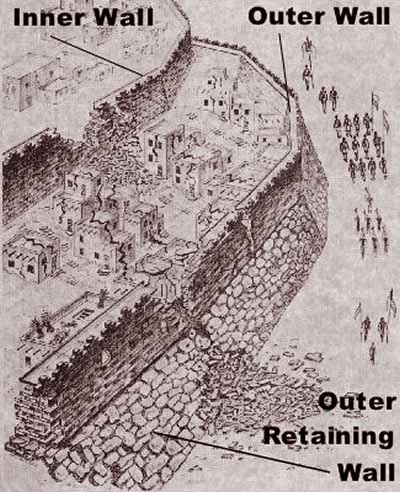
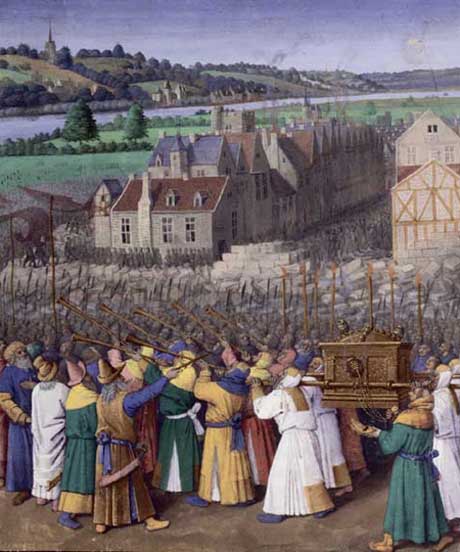
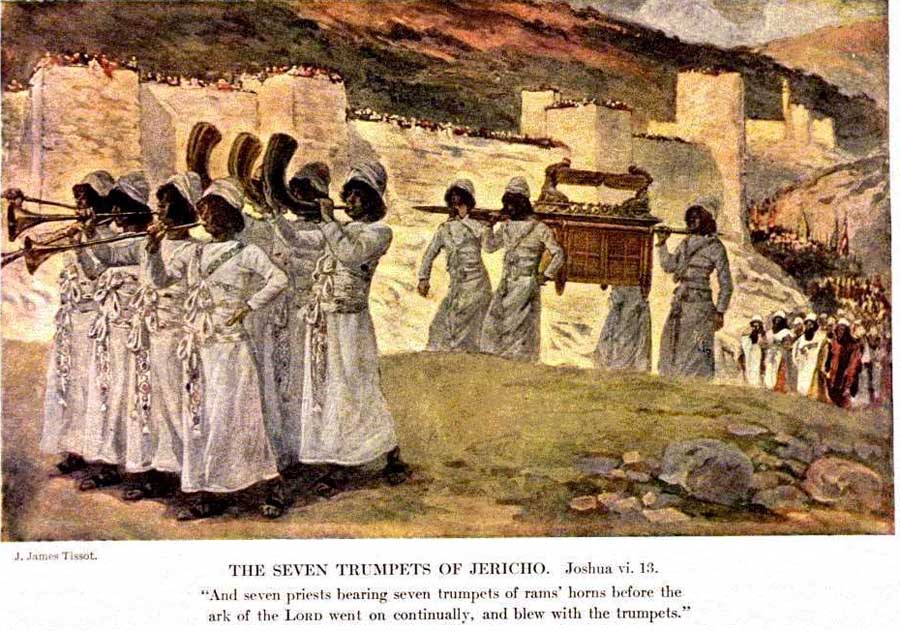
The Battle of Jericho is an incident in Bible's Book of Joshua,(Joshua 6:1-27) the first battle of the Israelites during their conquest of Canaan. According to the narrative, the walls of Jericho fell after Joshua's Israelite army marched around the city blowing their trumpets.
Before crossing into the land west of the River Jordan, Joshua sent two spies to look over the land. The king of Jericho heard that two Israelite spies were within his city and ordered them to be brought out to him. The spies were charged with ascertaining where the guards were placed, whether anyone disliked the king and could help them, what weaponry and armor the guards had, when the guards changed shifts, how much food, water, and other supplies the city had, and the height and width of the walls so as to determine how to overcome the city.
The woman with whom the spies were staying was named Rahab and she protected them by hiding the two men on her roof. She tells them how the citizens of Jericho had been fearful of the Israelites ever since they defeated the Egyptians via the Red Sea miracle (some 40 years prior), and agrees to cover for them on condition that she and her family are spared in the upcoming battle. The spies agree provided three conditions are met:
Her family must be inside the house during the battle, and
She must not later turn in the spies.
Rahab agrees to the conditions: she hangs a scarlet rope outside her window to distinguish her house from the others.
Safely escaping the city, the two returned to Joshua and reported that the "whole land was melting with fear."
The biblical account describes the Israelites being led by Joshua and crossing the Jordan into Canaan where they laid siege to the city of Jericho. There, God spoke to Joshua telling him to march around the city once every day for six days with the seven priests carrying ram's horns in front of the ark. On the seventh day they were to march around the city seven times and the priests were to blow their ram's horns. This Joshua did, and he commanded his people not to give a war-cry until he told them to do so.
On the seventh day, after marching around the city the seventh time, the priests sounded their ram's horns, and Joshua ordered the people to shout. The walls of the city collapsed, and the Israelites were able to charge straight into the city. The city was completely destroyed, and every man, woman, and child in it was killed. Only Rahab and her family were spared, because she had hidden the two spies sent by Joshua. After this, Joshua burned the remains of the city and cursed any man who would rebuild the city of Jericho would do so at the cost of his firstborn son. It is generally accepted that the biblical date for the fall of the walls is the 28th of Nisan, according to the Hebrew calendar.
In the 8th century BCE the Assyrians invaded from the north, followed by the Babylonians, and Jericho was depopulated between 586 and 538 BCE, the period of the Jewish exile to Babylon. Cyrus the Great, the Persian king, refounded the city one mile southeast of its historic site at the mound of Tell es-Sultan and returned the Jewish exiles after conquering Babylon in 539 BCE.
Jericho went from being an administrative centre of Yehud Medinata under Persian rule to serving as the private estate of Alexander the Great between 336 and 323 BCE after his conquest of the region. In the middle of the 2nd century BCE Jericho was under Hellenistic rule of the Seleucid Empire, when the Syrian General Bacchides built a number of forts to strengthen the defences of the area around Jericho against the revolt by the Macabees.
One of these forts, built at the entrance to Wadi Qelt, was later refortified by Herod the Great, who named it Kypros after his mother.
The city came to be ruled by the Hasmoneans, following the success of the Maccabean Revolt, and remained such until the Roman influence over the area brought Herod to claim the Hasmenean throne of Judea.
Herod originally leased Jericho from Cleopatra, after Mark Antony gave it to her as a gift. After their joint suicide in 30 BCE, Octavian assumed control of the Roman Empire and granted Herod free rein over Jericho, as part of the new Herodian domain. Herod’s rule oversaw the construction of a hippodrome-theatre (Tel es-Samrat) to entertain his guests and new aqueducts to irrigate the area below the cliffs and reach his winter palace built at the site of Tulul al-Alaiq.
The dramatic murder of Aristobulus III in a swimming pool in Jericho, as told by the Roman Jewish historian Josephus, took place during a banquet organized by Herod's Hasmonean mother-in-law. After the construction of its palaces the city had functioned not only as an agricultural center and as a crossroad but as a winter resort for Jerusalem's aristocracy.
The rock-cut tombs of a Herodian and Hasmonean era cemetery lie in the lowest part of the cliffs between Nuseib al-Aweishireh and Jebel Quruntul in Jericho and were used between 100 BCE and 68 CE.
The Christian Gospels state that Jesus passed through Jericho where he healed one or two blind beggars and inspired a local chief tax-collector named Zacchaeus to repent of his dishonest practices. The road between Jerusalem and Jericho is the setting for the Parable of the Good Samaritan
After the fall of Jerusalem to Vespasian's armies in the Great Revolt of Judea in 70 CE, Jericho declined rapidly, and by 100 CE it was but a small Roman garrison town. A fort was built there in 130 and played a role in putting down the Bar Kochba revolt in 133. Accounts of Jericho by a Christian pilgrim are given in 333. Shortly thereafter the built-up area of the town was abandoned and a Byzantine Jericho, Ericha, was built a mile to the east, around which the modern town is centred. Christianity took hold in the city during the Byzantine era and the area was heavily populated. A number of monasteries and churches were built, including St George of Koziba in 340 CE and a domed church dedicated to Saint Eliseus. At least two synagogues were also built in the 6th century CE.The monasteries were abandoned after the Persian invasion of 614.
Jericho, by then named "Ariha" in Arabic variation, fell under the Bilad al-Sham in district (jund) "al-Filastin". The Arab Muslim historian Musa b. 'Uqba (d. 141 / 758) recorded that caliph 'Umar exiled the Jews and Christians of Khaybar into Jericho (and Tayma).
By 659 that district had come under the control of Mu'awiya, founder of the Umayyads as a dynasty. That year, an earthquake struck Jericho and destroyed nearly all of it. A decade later the pilgrim Arculf visited Jericho and found it a ruin, all its "miserable Canaanite" inhabitants now dispersed in shantytowns around the Dead Sea shore.
The tenth caliph of that dynasty, Hisham ibn Abd al-Malik, built a palatial complex known as Khirbet al-Mafjar about one mile north of Tell as-Sultan in 743, and two mosques, a courtyard, mosaics, and other items from it can still be seen in situ today, despite its having been partially destroyed in an earthquake in 747.
Umayyad rule ended in 750 and was followed by the Arab caliphates of the Abbasid and Fatimid dynasties. Irrigated agriculture was developed under Islamic rule, reaffirming Jericho's reputation as a fertile "City of the Palms". Al-Maqdisi, the Arab geographer, wrote in 985 that, "the water of Jericho is held to be the highest and best in all Islam. Bananas are plentiful, also dates and flowers of fragrant odor." Jericho is also referred to by him as one of the principal cities of Jund Filastin.
The city flourished until 1071 and the invasion of the Seljuk Turks, followed by the upheavals of the Crusades.
In 1179, the Crusaders rebuilt the Monastery of St. George of Koziba, at its original site six miles from the center of town. They also built another two churches and a monastery dedicated to John the Baptist, and are credited with introducing sugarcane production to the city.
In 1187, the Crusaders were evicted by the Ayyubid forces of Saladin after their victory in the Battle of Hattin, and the town slowly went into decline.
In 1226, Arab geographer Yaqut al-Hamawi said of Jericho, "it has many palm trees, also sugarcane in quantities, and bananas. The best of all the sugar in the Ghaur land is made here." In the 14th century, Abu al-Fida writes there are sulfur mines in Jericho, "the only ones in Palestine."
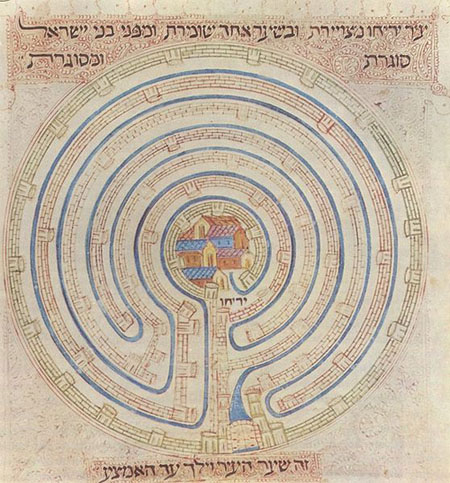
14th century map of Jericho in Farchi Bible
In the late years of Ottoman rule, Jericho formed part of the waqf and imerat of Jerusalem. The villagers processed indigo as one source of revenue, using a cauldron specifically for this purpose that was loaned to them by the Ottoman authorities in Jerusalem.
For most of the Ottoman period, Jericho was a small village of farmers susceptible to attacks by Bedouins. The French traveller Laurent d'Arvieux described the city in 1659 as "now desolate, and consists only of about fifty poor houses, in bad condition... The plain around is extremely fertile; the soil is middling fat; but it is watered by several rivulets, which flow into the Jordan. Notwithstanding these advantages. only the gardens adjacent to the town are cultivated."
In the 19th century, European scholars, archaeologists and missionaries visited often. The first excavation at Tell as-Sultan was carried out in 1867, and the monasteries of St. George of Koziba and John the Baptist were refounded and completed in 1901 and 1904, respectively.
After the collapse of the Ottoman empire at the end of World War I, Jericho came under the rule of the British Mandate. The British built fortresses in Jericho during World War II with the help of the Jewish company Solel Boneh, and bridges were rigged with explosives in preparation for a possible invasion by German allied forces.
Jericho was captured by the Hashemite Kingdom of Jordan during the 1948 Arab-Israeli war. The Jericho Conference, organized by King Abdullah and attended by over 2,000 Palestinian delegates in 1948 proclaimed "His Majesty Abdullah as King of all Palestine" and called for "the unification of Palestine and Transjordan as a step toward full Arab unity." In mid-1950, Jordan formally annexed the West Bank and Jericho residents, like other residents of West Bank localities became Jordanian citizens.
Jericho was captured by Israel during the Six-Day War of 1967 along with the rest of the West Bank. It was one of the first cities handed over to Palestinian Authority control in 1994, in accordance with the Oslo accords.
In 1994, Israel and the Palestinians signed a sweeping agreement laying the foundations for economic relations between Israel, Jericho and other cities under Palestinian self-rule.
In 2001, during the Second Intifada, Jericho was retaken by Israel. On 14 March 2006, the Israel Defense Forces launched Operation Bringing Home the Goods, in which it took captive six inmates from a Jericho prison following a 10-hour siege. Israel's reason for the siege was to capture PFLP general secretary, Ahmad Sa'adat and five other inmates for the assassination of Israeli tourist minister Rehavam Zeevi. At least two people were killed and 35 wounded in the incident. Before the siege, British and American monitors were guarding the prison but withdrew, citing lax security arrangements. The siege caused an uproar amongst the PFLP members and supporters as well as other PLO factions, and as a result Palestinian militants raided and kidnapped British and European citizens in the West Bank and Gaza Strip.
After Hamas assaulted a neighborhood in Gaza mostly populated by the Fatah-aligned Hilles clan in response to their attack on Hamas which killed six of its members, the Hilles clan was relocated to Jericho on August 4, 2008.
The first excavations of the site were made by Charles Warren in 1868. Ernst Sellin and Carl Watzinger excavated Tell es-Sultan and Tulul Abu el-'Alayiq between 1907–1909 and in 1911, and John Garstang excavated between 1930 and 1936. Extensive investigations using more modern techniques were made by Kathleen Kenyon between 1952 and 1958. Lorenzo Nigro and Nicolo Marchetti conducted excavations in 1997-2000. Since 2009 the Italian-Palestinian archaeological project of excavation and restoration was resumed by Rome "La Sapienza" University and Palestinian MOTA-DACH under the direction of Lorenzo Nigro and Hamdan Taha.
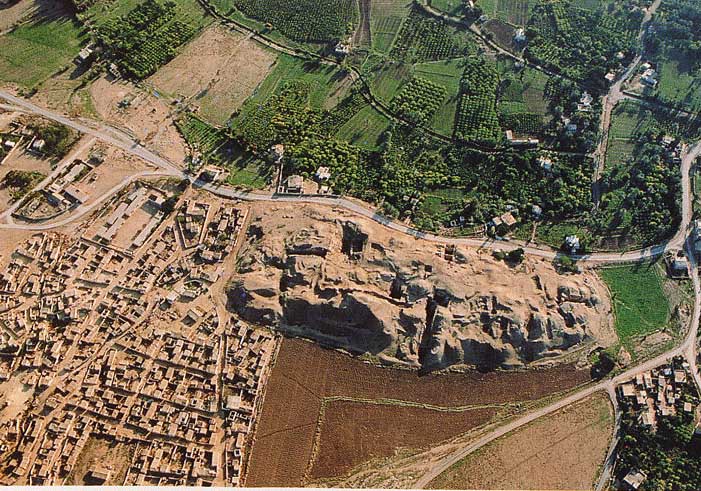
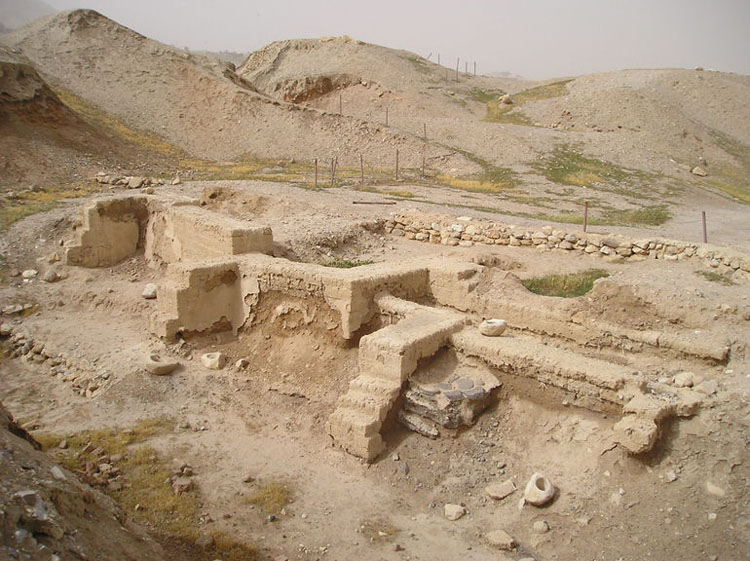
The earliest settlement was located at the present-day Tell es-Sultan (or Sultan's Hill), a couple of kilometers from the current city. In Arabic and in Hebrew, tell means "mound" - consecutive layers of habitation built up a mound over time, as is common for ancient settlements in the Middle East and Anatolia. Jericho is the type site for the Pre-Pottery Neolithic A (PPN A) and B periods.
Epipaleolithic - construction at the site appears to predate the invention of agriculture, with the construction of Natufian culture structures beginning earlier than 9000 BCE, the very beginning of the Holocene epoch in geologic history.
Pre-Pottery Neolithic A (8350-7370 BCE); sometimes it is called Sultanian. The site is a 40,000 square metre settlement surrounded by the Wall of Jericho, with the Tower of Jericho in the centre of one wall. Along with Tell Qaramel, this is one of the first walls ever to be discovered, thus suggesting some kind of social organization. The town contained round mud-brick houses, yet no street planning. The identity and number of the inhabitants (some sources say 2000–3000 dwellers) of Jericho during the PPN A period is still under debate, though it is known that they had domesticated emmer wheat, barley and pulses and hunted wild animals.
Pre-Pottery Neolithic B, 7220 - 5850 BCE (but carbon-14-dates are few and early). Expanded range of domesticated plants. Possible domestication of sheep. Apparent cult involving the preservation of human skulls, with facial features reconstructed from plaster and eyes set with shells in some cases.
After the PPN A settlement-phase there was a settlement hiatus of several centuries, then the PPN B settlement was founded on the eroded surface of the tell. The architecture consisted of rectilinear buildings made of mudbricks on stone foundations. The mudbricks were loaf-shaped with deep thumb prints to facilitate bounding. No building has been excavated in its entirety. Normally, several rooms cluster around a central courtyard. The rooms have red or pinkish terrazzo-floors made of lime. Some impressions of mats made of reeds or rushes have been preserved. The courtyards have clay floors.
Kathleen Kenyon interpreted one building as a shrine. It contained a niche in the wall. A chipped pillar of volcanic stone that was found nearby might have fit into this niche.
The dead were buried under the floors or in the rubble fill of abandoned buildings. There are several collective burials. Not all the skeletons are completely articulated, which may point to a time of exposure before burial. A skull cache contained seven skulls. The jaws were removed and the faces covered with plaster; cowries were used as eyes. A total of ten skulls were found. Modeled skulls were found in Tell Ramad and Beisamoun as well.
Other finds included flints, such as arrowheads (tanged or side-notched), finely denticulated sickle-blades, burins, scrapers, a few tranchet axes, obsidian, and green obsidian from an unknown source. There were also querns, hammerstones, and a few ground-stone axes made of greenstone. Other items discovered included dishes and bowls carved from soft limestone, spindle whorls made of stone and possible loom weights, spatulae and drills, stylized anthropomorphic plaster figures, almost life-size, anthropomorphic and theriomorphic clay figurines, as well as shell and malachite beads.
In the late 4th millennium BCE, Jericho was occupied during Neolithic 2 and the general character of the remains on the site link it culturally with Neolithic 2 sites in the West Syrian and Middle Euphrates groups. This link is established by the presence of rectilinear mud-brick buildings and plaster floors that are characteristic of the age.
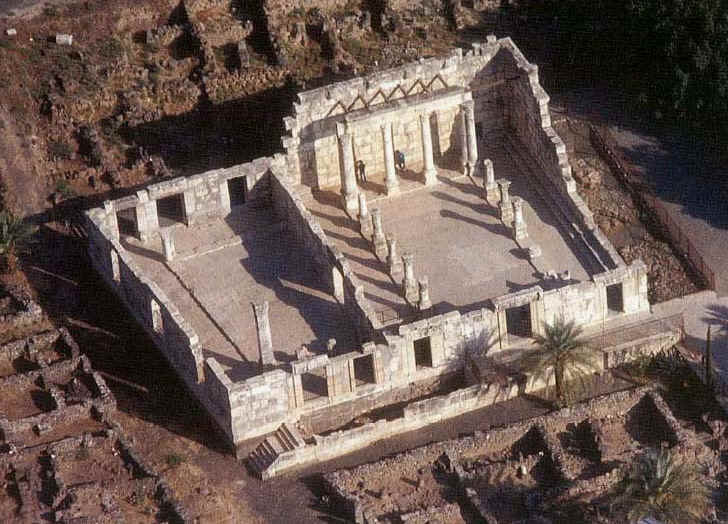
The Jericho Synagogue (Wadi Qelt Synagogue) in the Royal Maccabean winter palace at Jericho dates from 70-50 BCE.
A synagogue dating to the late 6th or early 7th century CE was discovered in Jericho in 1936, and was named Shalom Al Israel, or "peace unto Israel", after the central Hebrew motto in its mosaic floor. It was controlled by Israel after the Six Day War, but after the handover to Palestinian Authority control per the Oslo Accords, it has been a source of conflict. On the night of October 12, 2000, the synagogue was vandalized by Palestinians who burned holy books and relics and damaged the mosaic.
The Na'aran synagogue, another Byzantine era construction, was discovered on the northern outskirts of Jericho in 1918. While less is known of it than Shalom Al Israel, it has a larger mosaic and is in similar condition. Jericho Read more..